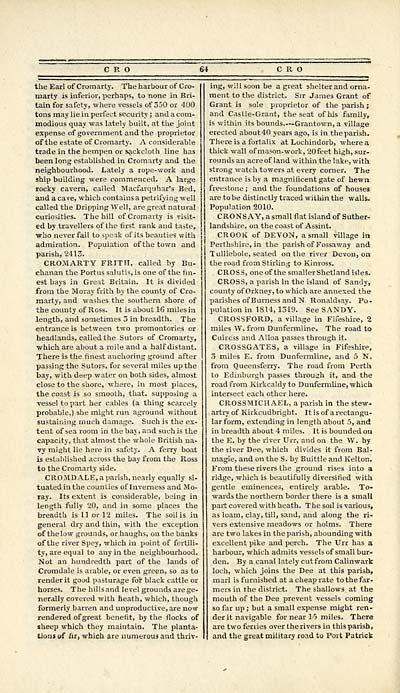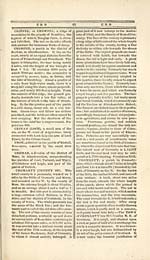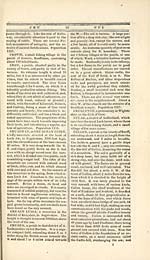Gazetteer of Scotland
(66) Page 64
Download files
Complete book:
Individual page:
Thumbnail gallery: Grid view | List view

CRO
the Earl of Cromarty. The harbour of Cro-
marty is inferior, perhaps, to none in Bri-
tain for safety, where vessels of 350 or 400
tons may lie in perfect security ; and a com-
modious quay was lately built, at the joint
expense of government and the proprietor
of the estate of Cromarty. A considerable
trade in the hempen or sackcloth line has
been long established in Cromarty and the
neighbourhood. Lately a rope-work and
ship building were commenced. A large
rocky cavern, called Macfarquhar's Bed,
and a cave, which contains a petrifying well
called the Dripping Well, are great natural
curiosities. The hill of Cromarty is visit-
ed by travellers of the first rank and taste,
who never fail to speak of its beauties with
admiration. Population of the town and
parish, 2413.
CROMARTY FRITH, called by Bu-
chanan the Port us salutis, is one of the fin-
est bays in Great Britain. It is divided
from the Moray frith by the county of Cro-
marty, and washes the southern shore of
the county of Ross. It is about 16 miles in
length, and sometimes 3 in breadth. The
entrance is between two promontories or
headlands, called the Sutors of Cromarty,
■which are about a mile and a half distant.
There is the finest anchoring ground after-
passing the Sutors, for several miles up the
bay, with deep water on both sides, almost
close to the shore, where, in most places,
the coast is so smooth, that, supposing a
vessel to part her cables (a thing scarcely
probable,) she might run aground without
sustaining much damage. Such is the ex-
tent of sea room in the baj, and such is the
capacity, that almost the whole British na-
vy might lie here in safety. A ferry boat
is established across the bay from the Ross
to the Cromarty side.
CROMDALE, a parish, nearly equally si-
tuated in the counties of Inverness and Mo-
ray. Its extent is considerable, being in
length fully 20, and in some places the
breadth is 11 or 12 miles. The soilis in
general dry and thin, with the exception
of the low grounds, or haughs, on the banks
of the river Spey, which in point of fertili-
ty, are equal to any in the neighbourhood.
Not an hundredth part of the lands of
Cromdale is arable, or even green, so as to
render it good pasturage for black cattle or
horses. The hills and level grounds are ge-
nerally covered with heath, which, though
formerly barren and unproductive, are now-
rendered of great benefit, by the flocks of
sheep which they maintain. The planta-
tions of nr, which are numerous and thriv-
CRO
ing, will soon be a great shelter and orna-
ment to the district. Sir James Grant of
Grant is sole proprietor of the parish ;
and Castle-Grant, the seat of his family,
is within its bounds — Grantown, a village
erected about 40 years ago, is in the parish.
Thereisafortalix at Lochindorb, where a
thick wall of mason- work, 20feet high, sur-
rounds an acre of land within the lake, with
strong watch towers at every corner. The
entrance is by a magnificent gate of hewn
freestone ; and the foundations of houses
are to be distinctly traced within the walls.
Population 2010.
CRONS AY, a small flat island of Suther-
landshire, on the coast of Assint.
CROOK of DEVON, a small village in
Perthshire, in the parish of Fossaway and
Tulliebole, seated on the river Devon, on
the road from Stirling to Kinross.
CROSS, one of the smaller Shetland isles.
CROSS, a parish in the island of Sandy,
county of Orkney, to which are annexed the
parishes of Bumess and N Ronaldsay. Po-
pulation in 1814, 1519. See SANDY.
CROSSFORD, a village in Fifeshire, 2
miles W. from Dunfermline. The road to
duress and Alloa passes through it.
CROSSGATES, a village in Fifeshire,
." miles E. from Dunfermline, and 5 N.
from Queensferry. The road from Perth
to Edinburgh passes through it, and the
road from Kirkcaldy to Dunfermline, which
intersect each other here.
CROSSMICHAEL, a parish in the stew-
artry of Kirkcudbright. It is of a rectangu-
lar form, extending in length about 5, and
in breadth about 4 miles. It is bounded on
the E. by the river Urr, and on the W. by
the river Dee, which divides it from Bal-
magie, and on the S. by Buittle and Kelton.
From these rivers the ground rises into a
ridge, which is beautifully diversified with
gentle eminences, entirely arable. To-
wards the northern border there is a small
part covered with heath. The soil is various,
as loam, clay, till, sand, and along the ri-
vers extensive meadows or holms. There
are two lakes in the parish, abounding with
excellent pike and perch. The Urr has a
harbour, which admits vessels of small bur-
den. By a canal lately cut from Calinwark
loch, which joins the Dee at this parish,
marl is furnished at a cheap rate to the far-
mers in the district. The shallows at the
mouth of the Dee prevent vessels coming
so far up ; but a small expense might ren-
der it navigable for near l r > miles. There
are two ferries over therivers in this parish,
and the great military road to Port Patrick
the Earl of Cromarty. The harbour of Cro-
marty is inferior, perhaps, to none in Bri-
tain for safety, where vessels of 350 or 400
tons may lie in perfect security ; and a com-
modious quay was lately built, at the joint
expense of government and the proprietor
of the estate of Cromarty. A considerable
trade in the hempen or sackcloth line has
been long established in Cromarty and the
neighbourhood. Lately a rope-work and
ship building were commenced. A large
rocky cavern, called Macfarquhar's Bed,
and a cave, which contains a petrifying well
called the Dripping Well, are great natural
curiosities. The hill of Cromarty is visit-
ed by travellers of the first rank and taste,
who never fail to speak of its beauties with
admiration. Population of the town and
parish, 2413.
CROMARTY FRITH, called by Bu-
chanan the Port us salutis, is one of the fin-
est bays in Great Britain. It is divided
from the Moray frith by the county of Cro-
marty, and washes the southern shore of
the county of Ross. It is about 16 miles in
length, and sometimes 3 in breadth. The
entrance is between two promontories or
headlands, called the Sutors of Cromarty,
■which are about a mile and a half distant.
There is the finest anchoring ground after-
passing the Sutors, for several miles up the
bay, with deep water on both sides, almost
close to the shore, where, in most places,
the coast is so smooth, that, supposing a
vessel to part her cables (a thing scarcely
probable,) she might run aground without
sustaining much damage. Such is the ex-
tent of sea room in the baj, and such is the
capacity, that almost the whole British na-
vy might lie here in safety. A ferry boat
is established across the bay from the Ross
to the Cromarty side.
CROMDALE, a parish, nearly equally si-
tuated in the counties of Inverness and Mo-
ray. Its extent is considerable, being in
length fully 20, and in some places the
breadth is 11 or 12 miles. The soilis in
general dry and thin, with the exception
of the low grounds, or haughs, on the banks
of the river Spey, which in point of fertili-
ty, are equal to any in the neighbourhood.
Not an hundredth part of the lands of
Cromdale is arable, or even green, so as to
render it good pasturage for black cattle or
horses. The hills and level grounds are ge-
nerally covered with heath, which, though
formerly barren and unproductive, are now-
rendered of great benefit, by the flocks of
sheep which they maintain. The planta-
tions of nr, which are numerous and thriv-
CRO
ing, will soon be a great shelter and orna-
ment to the district. Sir James Grant of
Grant is sole proprietor of the parish ;
and Castle-Grant, the seat of his family,
is within its bounds — Grantown, a village
erected about 40 years ago, is in the parish.
Thereisafortalix at Lochindorb, where a
thick wall of mason- work, 20feet high, sur-
rounds an acre of land within the lake, with
strong watch towers at every corner. The
entrance is by a magnificent gate of hewn
freestone ; and the foundations of houses
are to be distinctly traced within the walls.
Population 2010.
CRONS AY, a small flat island of Suther-
landshire, on the coast of Assint.
CROOK of DEVON, a small village in
Perthshire, in the parish of Fossaway and
Tulliebole, seated on the river Devon, on
the road from Stirling to Kinross.
CROSS, one of the smaller Shetland isles.
CROSS, a parish in the island of Sandy,
county of Orkney, to which are annexed the
parishes of Bumess and N Ronaldsay. Po-
pulation in 1814, 1519. See SANDY.
CROSSFORD, a village in Fifeshire, 2
miles W. from Dunfermline. The road to
duress and Alloa passes through it.
CROSSGATES, a village in Fifeshire,
." miles E. from Dunfermline, and 5 N.
from Queensferry. The road from Perth
to Edinburgh passes through it, and the
road from Kirkcaldy to Dunfermline, which
intersect each other here.
CROSSMICHAEL, a parish in the stew-
artry of Kirkcudbright. It is of a rectangu-
lar form, extending in length about 5, and
in breadth about 4 miles. It is bounded on
the E. by the river Urr, and on the W. by
the river Dee, which divides it from Bal-
magie, and on the S. by Buittle and Kelton.
From these rivers the ground rises into a
ridge, which is beautifully diversified with
gentle eminences, entirely arable. To-
wards the northern border there is a small
part covered with heath. The soil is various,
as loam, clay, till, sand, and along the ri-
vers extensive meadows or holms. There
are two lakes in the parish, abounding with
excellent pike and perch. The Urr has a
harbour, which admits vessels of small bur-
den. By a canal lately cut from Calinwark
loch, which joins the Dee at this parish,
marl is furnished at a cheap rate to the far-
mers in the district. The shallows at the
mouth of the Dee prevent vessels coming
so far up ; but a small expense might ren-
der it navigable for near l r > miles. There
are two ferries over therivers in this parish,
and the great military road to Port Patrick
Set display mode to: Large image | Transcription
Images and transcriptions on this page, including medium image downloads, may be used under the Creative Commons Attribution 4.0 International Licence unless otherwise stated. ![]()
| Gazetteers of Scotland, 1803-1901 > Gazetteer of Scotland > (66) Page 64 |
|---|
| Permanent URL | https://digital.nls.uk/97422486 |
|---|

